- Joined
- Oct 9, 2007
- Messages
- 47,231 (7.55/day)
- Location
- Hyderabad, India
| System Name | RBMK-1000 |
|---|---|
| Processor | AMD Ryzen 7 5700G |
| Motherboard | ASUS ROG Strix B450-E Gaming |
| Cooling | DeepCool Gammax L240 V2 |
| Memory | 2x 8GB G.Skill Sniper X |
| Video Card(s) | Palit GeForce RTX 2080 SUPER GameRock |
| Storage | Western Digital Black NVMe 512GB |
| Display(s) | BenQ 1440p 60 Hz 27-inch |
| Case | Corsair Carbide 100R |
| Audio Device(s) | ASUS SupremeFX S1220A |
| Power Supply | Cooler Master MWE Gold 650W |
| Mouse | ASUS ROG Strix Impact |
| Keyboard | Gamdias Hermes E2 |
| Software | Windows 11 Pro |
Intel today concluded its client-segment processor launch series with the introduction of the new 14th Gen Core "Raptor Lake Refresh" desktop processor family with 65 W (non-K) models. These would fill the gaps between the various unlocked "K" 125 W SKUs Intel launched in October 2023. All processor models in the series come with base power values of 65 W, with maximum turbo power ranging between 110 W for the Core i3 4P+0E processors, to roughly 154 W for the Core i5 6P+8E processors, to 220 W for the Core i7 8P+12E processors, and as high as 225 W for the top Core i9 8P+16E models.
The Core i9-14900 and i9-14900F offer a maximum P-core boost frequency in line with their K and KF counterparts, of 6.00 GHz, although their base frequency is lowered in line with their reduced base power. The Core i7-14700 and i7-14700F tick at speeds of up to 5.60 GHz. The Core i9 and Core i7 series processor models make use of the "Raptor Lake Refresh" silicon that has 2 MB of L2 cache per P-core, 4 MB of L2 cache per E-core cluster, and up to 36 MB of L3 cache; while the 65 W Core i5 series is based on the smaller silicon that has 1.25 MB of L2 cache per P-core, 2 MB of L2 cache per E-core cluster, and up to 30 MB of L3 cache.
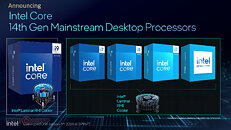
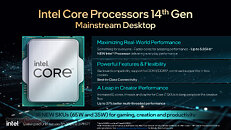
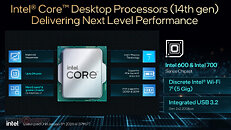
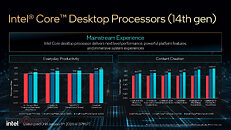
The 14th Gen Core i5 series sees 6P+8E as the core configuration across the line, along with 24 MB of L3 cache. The top Core i5-14500 ticks at up to 5.10 GHz for the P-cores, and up to 3.90 GHz on the E-cores. The entry-level Core i3 series continues to be 4-core/8-thread, and lacking in E-cores. These chips are based on the smallest desktop silicon that lacks an E-core cluster, and only has up to 6 P-cores, and up to 18 MB of L3 cache. The Core i3-14100 is carved out of this by enabling four the P-cores, along with 12 MB of L3 cache. It ticks at speeds of up to 4.70 GHz. All Core i9, Core i7, and Core i5 processor models being launched today feature the same Intel UHD 770 integrated graphics, with 2 Xe cores (32 EU), while the Core i3 gets a smaller iGPU with just one Xe core, branded as UHD Graphics 730.
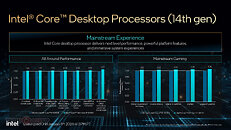
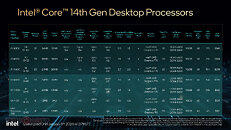
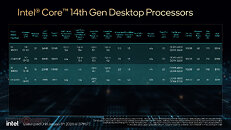
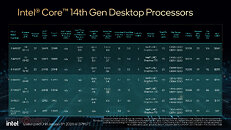
View at TechPowerUp Main Site
The Core i9-14900 and i9-14900F offer a maximum P-core boost frequency in line with their K and KF counterparts, of 6.00 GHz, although their base frequency is lowered in line with their reduced base power. The Core i7-14700 and i7-14700F tick at speeds of up to 5.60 GHz. The Core i9 and Core i7 series processor models make use of the "Raptor Lake Refresh" silicon that has 2 MB of L2 cache per P-core, 4 MB of L2 cache per E-core cluster, and up to 36 MB of L3 cache; while the 65 W Core i5 series is based on the smaller silicon that has 1.25 MB of L2 cache per P-core, 2 MB of L2 cache per E-core cluster, and up to 30 MB of L3 cache.




The 14th Gen Core i5 series sees 6P+8E as the core configuration across the line, along with 24 MB of L3 cache. The top Core i5-14500 ticks at up to 5.10 GHz for the P-cores, and up to 3.90 GHz on the E-cores. The entry-level Core i3 series continues to be 4-core/8-thread, and lacking in E-cores. These chips are based on the smallest desktop silicon that lacks an E-core cluster, and only has up to 6 P-cores, and up to 18 MB of L3 cache. The Core i3-14100 is carved out of this by enabling four the P-cores, along with 12 MB of L3 cache. It ticks at speeds of up to 4.70 GHz. All Core i9, Core i7, and Core i5 processor models being launched today feature the same Intel UHD 770 integrated graphics, with 2 Xe cores (32 EU), while the Core i3 gets a smaller iGPU with just one Xe core, branded as UHD Graphics 730.




View at TechPowerUp Main Site





